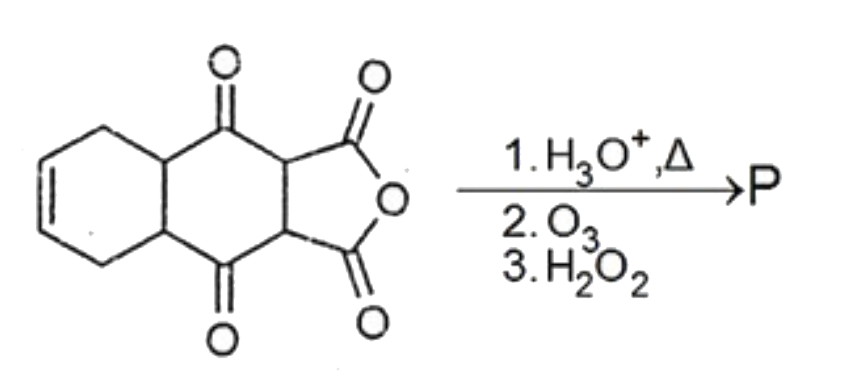P4+SOCl2Δ−−→Products
Find out total number of non-planar and polar molecules of products in balanced equation for one mole of P4.
The correct Answer is:6
To solve the problem, we will follow these steps:
Step 1: Write the Reaction
We start with the reaction of phosphorus (P₄) with thionyl chloride (SOCl₂). The balanced chemical equation for the reaction is:
P4+8SOCl2→4PCl3+4SO2+2S2Cl2
Step 2: Identify the Products
From the balanced equation, we have three products:
1. Phosphorus trichloride (PCl₃)
2. Sulfur dioxide (SO₂)
3. Disulfur dichloride (S₂Cl₂)
Step 3: Determine the Geometry of Each Product
Next, we need to analyze the geometry of each product to determine if they are planar or non-planar.
1. PCl₃:
- Phosphorus has five valence electrons and forms three bonds with chlorine atoms, leaving one lone pair.
- The molecular geometry is trigonal pyramidal, which is non-planar.
2. SO₂:
- Sulfur has six valence electrons and forms two bonds with oxygen atoms, with one lone pair remaining.
- The molecular geometry is bent (or V-shaped), which is planar.
3. S₂Cl₂:
- Each sulfur atom forms a bond with another sulfur atom and two chlorine atoms.
- The structure is non-linear, and the geometry is also non-planar.
Step 4: Determine Polarity
Now we will check the polarity of each product:
1. PCl₃:
- It is a polar molecule due to the presence of a lone pair on phosphorus and the electronegativity difference between phosphorus and chlorine.
2. SO₂:
- It is also a polar molecule due to its bent shape and the difference in electronegativity between sulfur and oxygen.
3. S₂Cl₂:
- It is a polar molecule as well, due to the difference in electronegativity between sulfur and chlorine and its non-planar structure.
Step 5: Count Non-Planar and Polar Molecules
Now we summarize the findings:
- Non-Planar and Polar Molecules:
- PCl₃ (1)
- S₂Cl₂ (1)
- Planar and Polar Molecules:
- SO₂ (1)
Conclusion
The total number of non-planar and polar molecules from the products is:
- PCl₃: 4 moles (from the balanced equation)
- S₂Cl₂: 2 moles (from the balanced equation)
Thus, the total number of non-planar and polar molecules is:
4(PCl3)+2(S2Cl2)=6
Final Answer
The total number of non-planar and polar molecules of products in the balanced equation for one mole of P₄ is 6.
---
We start with the reaction of phosphorus (P₄) with thionyl chloride (SOCl₂). The balanced chemical equation for the reaction is:
P4+8SOCl2→4PCl3+4SO2+2S2Cl2
From the balanced equation, we have three products:
1. Phosphorus trichloride (PCl₃)
2. Sulfur dioxide (SO₂)
3. Disulfur dichloride (S₂Cl₂)
Next, we need to analyze the geometry of each product to determine if they are planar or non-planar.
- Phosphorus has five valence electrons and forms three bonds with chlorine atoms, leaving one lone pair.
- The molecular geometry is trigonal pyramidal, which is non-planar.
- Sulfur has six valence electrons and forms two bonds with oxygen atoms, with one lone pair remaining.
- The molecular geometry is bent (or V-shaped), which is planar.
- Each sulfur atom forms a bond with another sulfur atom and two chlorine atoms.
- The structure is non-linear, and the geometry is also non-planar.
Now we will check the polarity of each product:
- It is a polar molecule due to the presence of a lone pair on phosphorus and the electronegativity difference between phosphorus and chlorine.
- It is also a polar molecule due to its bent shape and the difference in electronegativity between sulfur and oxygen.
- It is a polar molecule as well, due to the difference in electronegativity between sulfur and chlorine and its non-planar structure.
Now we summarize the findings:
- Non-Planar and Polar Molecules:
- PCl₃ (1)
- S₂Cl₂ (1)
- SO₂ (1)
The total number of non-planar and polar molecules from the products is:
- PCl₃: 4 moles (from the balanced equation)
- S₂Cl₂: 2 moles (from the balanced equation)
4(PCl3)+2(S2Cl2)=6
The total number of non-planar and polar molecules of products in the balanced equation for one mole of P₄ is 6.
Topper's Solved these Questions
Similar Questions
Knowledge Check
- Question 1 - Select One

Find out structure of final product P.A B
B C
C D
D
P4+10Cl2Δ−−→PCl5
View SolutionP4+10Cl2Δ−−→PCl5
View SolutionThe total number of carboxylic acid groups in the product P is
 View Solution
View SolutionP4+NaOH−−→warm Products.
Write the productsView SolutionCopper sulphate reacts with NaCN to form a cyanide complex. Write the balanced equation and find the number of NaCN molecules involved in the equation for one mole of CuSO4.
View SolutionFeC2O4Δ−−→ products
Number of diamagnetic products=x
Number of unpaired electrons in paramagnetic products=y
report your answer as (x+y)View SolutionTotal number of hydroxyl groups present in a molecule of the major product P is________.
 View Solution
View Solution

